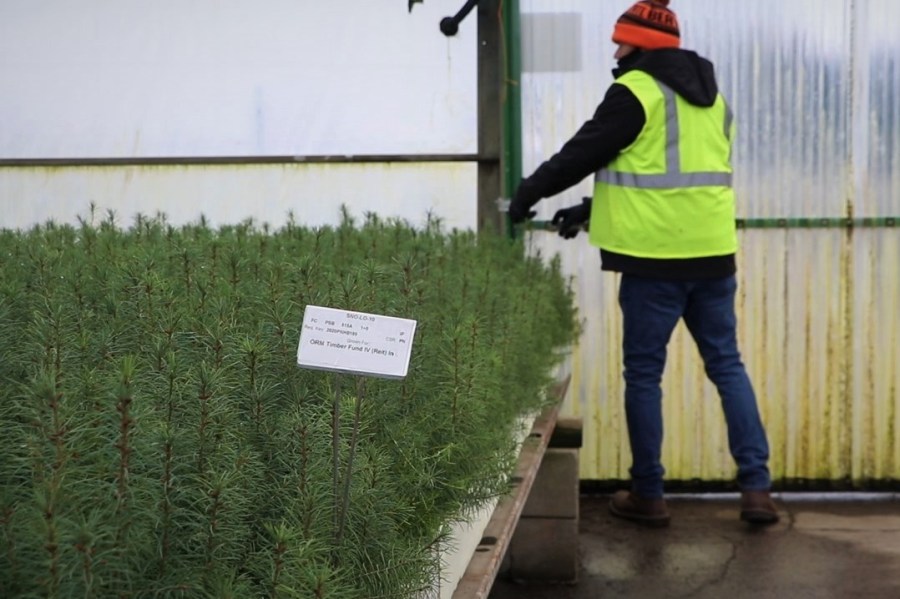MARION COUNTY, Ore. (KOIN) — Nursery workers are moving fast in Hubbard to get conifer seedlings shipped off to customers, and the wildfires that burned roughly 1.2 million acres in Oregon have given them a new sense of urgency, since millions of trees need to be replaced.
However, with limited capacity to grow new trees, it’s a process that’s expected to take several years.
“It was a disaster to be quite honest,” PRT nursery manager Allen Terlecki said, recalling the fires. “The smoke was so thick that at 9 in the morning here it was like midnight.”
Terlecki lives in the Abiqua Basin and was under level 3 evacuation orders more than once during the fires. He was worried about the nursery, though, making sure sprinklers were going and everything was watered around the 28-acre facility. In 2020, PRT shipped about 15 million tiny trees to customers, primarily in the timber industry.
The calls from frantic foresters poured in, even as September’s fires continued to rage: They needed to increase their seedling orders.
“We knew immediately this was gonna be a major challenge,” said Ted Reiss, timberlands manager at Seneca Jones Timber Company. “We could see that these fires were completely out of control.”
One of his lead foresters was on the phone with nurseries the day after the fires started.
Seneca would end up losing about 10,700 acres of trees in both the Holiday and Archie Creek fires.
“In some places, everything, absolutely everything was turned black and killed in the fire,” Reiss said. In other areas, the fire moved through, burned some trees, and left some alive.
The Oregon Department of Forestry (ODF) estimates almost 400,000 acres of private land burned in the 2020 fires.
Brent Parries, co-owner of Pacific Forest Contractors, Inc., a logging company based in Eagle Creek, said industrial landowners typically plant 350-500 trees per acre. So we could be looking at a need for tens, if not hundreds of millions of extra seedlings on top of the approximately 40 million trees already planted annually in Oregon.
Under the Oregon Forest Practices Act, timber land owners must replant within two years after a fire, if they salvage the timber. The agency has said it will make some allowances to extend the deadline for land owners who can’t obtain seedlings in time. Those who need an extension should contact ODF.
The main issue with replenishing Oregon’s seedling supply is nursery capacity. Most seeds are sown and grown inside greenhouses, which have a fixed amount of space. Terlecki said the 400,000 square feet of greenhouses at PRT already operate at capacity every year, filling orders for private and government lands all across the U.S. and even into British Columbia.

However, because PRT is part of a network of 19 nurseries, Terlecki said they were able to shuffle orders around to respond to the disastrous wildfires.
“We are now growing more trees here locally for the Pacific Northwest,” he said. It’s a trend he sees continuing for at least three to four years while they try to catch up with demand.
Most of PRT’s seedlings are less than a year old when they leave the nursery; sown in February and shipped off in the winter. Foresters generally plant seedlings between November and March to take advantage of cold, wet weather.
Crews plant the seedlings by hand, one tree at a time, Reiss said, which raises the additional concern of whether the industry will be able to get enough manpower to complete replanting in a timely fashion.
Capacity issues may trickle down to Christmas trees
Christmas trees were largely spared from the wildfires. Noble Mountain Tree Farm general manager Bob Schaefer told KOIN 6 News he knew of one operation near Mehama that lost a couple of fields, but the overall loss was minimal.
However, growers looking to plant new festive fir trees may run into challenges.
“We grow Douglas fir, just like the timber folks,” OSU Christmas tree specialist Chal Landgren said. “I think all the nursery capacity from California to British Columbia has already been taken up with people trying to get seedlings from the fires. And that’ll affect Christmas tree growers as well.”
Both Terlecki and Reiss are confident in the timber industry’s ability to bounce back, though.
“This was definitely a historic event,” Reiss said. “But the industry is strong. We’re poised, we have the professional capacity across the industry … to be able to rise to the challenge.”

KOIN 6 News digital enterprise reporter Amanda Arden contributed to this report.




